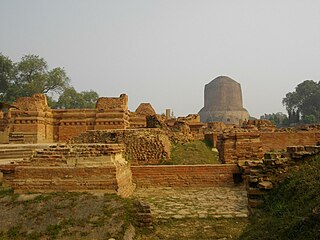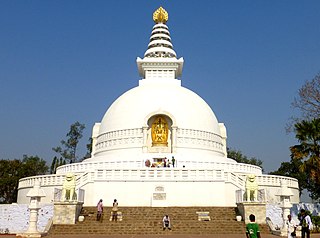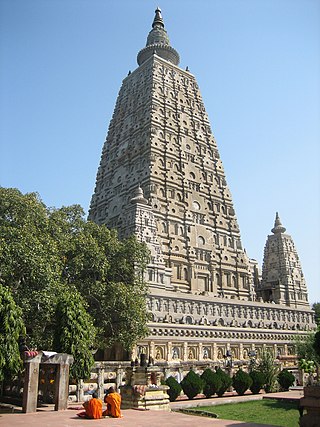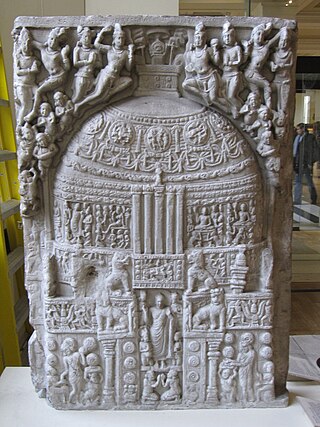
Nalanda was a renowned Buddhist mahavihara in ancient and medieval Magadha, eastern India. Widely considered to be among the greatest centres of learning in the ancient world, and often referred to as "the world's first residential university", it was located near the city of Rajagriha, roughly 90 kilometres (56 mi) southeast of Pataliputra. Operating from 427 CE until around 1400 CE, Nalanda played a vital role in promoting the patronage of arts and academics during the 5th and 6th century CE, a period that has since been described as the "Golden Age of India" by scholars.

Xuanzang, born Chen Hui or Chen Yi, also known by his Sanskrit Dharma name Mokṣadeva, was a 7th-century Chinese Buddhist monk, scholar, traveler, and translator. He is known for the epoch-making contributions to Chinese Buddhism, the travelogue of his journey to India in 629–645, his efforts to bring at least 657 Indian texts to China, and his translations of some of these texts. He was only able to translate 75 distinct sections of a total of 1335 chapters, but his translations included some of the most important Mahayana scriptures.

Sarnath is a place located 10 kilometres northeast of Varanasi, near the confluence of the Ganges and the Varuna rivers in Uttar Pradesh, India.

Faxian, formerly romanized as Fa-hien and Fa-hsien, was a Chinese Buddhist monk and translator who traveled on foot from Jin China to medieval India to acquire Buddhist scriptures. His birth name was Gong Sehi. Starting his journey about age 60, he traveled west along the overland Silk Road, visiting Buddhist sites in Central, South, and Southeast Asia. The journey and return took from 399 to 412, with 10 years spent in India.

Rajgir, old name Rajagriha, meaning "The City of Kings," is an ancient city and university town in the district of Nalanda in Bihar, India. As the ancient seat and capital of the Haryanka dynasty, the Pradyota dynasty, the Brihadratha dynasty and the Mauryan Empire, as well as the dwelling ground of such historical figures as Buddha, Mahavira and Bimbisara, the city holds a place of prominence in Hindu, Buddhist and Jain scriptures. As of 2011, the population of the town was reported to be 41,000 while the population in the community development block was about 88,500.

Vikramashila was a Buddhist monastery situated in what is now modern-day Bihar in India. It was founded by King Dharmapala between the late eighth and early ninth century.

Major General Sir Alexander Cunningham was a British Army engineer with the Bengal Sappers who later took an interest in the history and archaeology of India. In 1861, he was appointed to the newly created position of archaeological surveyor to the government of India; and he founded and organised what later became the Archaeological Survey of India.

Shravasti ; Pali: 𑀲𑀸𑀯𑀢𑁆𑀣𑀻, romanized: Sāvatthī) is a town in Shravasti district in Indian state of Uttar Pradesh. It was the capital of the ancient Indian kingdom of Kosala and the place where the Buddha lived most after his enlightenment. It is near the Rapti river in the northeastern part of Uttar Pradesh India, close to the Nepalese border.
Samuel Beal was an Oriental scholar, and the first Englishman to translate directly from the Chinese the early records of Buddhism, thus illuminating Indian history.

Dhamek Stupa is a massive stupa located at the archaeological site of Sarnath in the state of Uttar Pradesh, India. Dhamek Stupa marks the location where the Buddha preached his first discourse to his first five disciples, and where all five eventually became fully liberated.

Pushpagiri was an ancient Indian mahavihara or monastic complex located atop Langudi Hill in Jajpur district of Odisha, India. Pushpagiri was mentioned in the writings of the Chinese traveller Xuanzang and some other ancient sources. Until the 1990s, it was hypothesised to be one or all of the Lalitgiri-Ratnagiri-Udayagiri group of monastic sites, also located in Jajpur district. These sites contain ruins of many buildings, stupas of various sizes, sculptures, and other artifacts.

The state of Bihar in eastern India, is one of the oldest inhabited places in the world with a history going back 3000 years. The rich culture and heritage of Bihar is evident from the innumerable ancient monuments that are dotted all over the state. Bihar is home to many tourist attractions and is visited by large numbers of tourists from all over the world. Around total 6 million tourists visit Bihar every year.
Kesaria, also known as Kesariya is a town in the district of East Champaran, in the Indian state of Bihar. It is the site of a stupa built by the Mauryan king Ashoka.

Kushinagar is a town in the Kushinagar district in Uttar Pradesh, India. Located 53 kilometres east of Gorakhpur on National Highway 27, Kushinagar is an important and popular Buddhist pilgrimage site, where Buddhists believe Gautama Buddha died and attained parinirvana.

According to the Mahāparinibbāṇa Sutta, after attaining parinirvana, the body of Buddha was cremated and the ashes divided among his lay followers.
Mahavihara is the Sanskrit and Pali term for a great vihara and is used to describe a monastic complex of viharas.

Amarāvati Stupa is a ruined Buddhist stūpa at the village of Amaravathi, Palnadu district, Andhra Pradesh, India, probably built in phases between the third century BCE and about 250 CE. It was enlarged and new sculptures replaced the earlier ones, beginning in about 50 CE. The site is under the protection of the Archaeological Survey of India, and includes the stūpa itself and the Archaeological Museum.

Giriyak is a village and community development block located on the bank of the Panchane River in Nalanda district of Bihar, India. It is located about 15 kilometres east of Rajgir, 26 kilometres south of Bihar Sharif, the district headquarters, and 95 kilometres southeast of Patna, the state capital.

Ancient Indian architecture ranges from the Indian Bronze Age to around 800 CE. By this endpoint Buddhism in India had greatly declined, and Hinduism was predominant, and religious and secular building styles had taken on forms, with great regional variation, which they largely retain even after some forceful changes brought about by the arrival of first Islam, and then Europeans.

Telhara was a Buddhist monastic establishment in Nalanda district of Bihar, India dating back to the 1st-century CE and active till at least the 12th-century CE. It is notable as it has been mentioned in the travelogues of Chinese monks including Xuanzang.





















